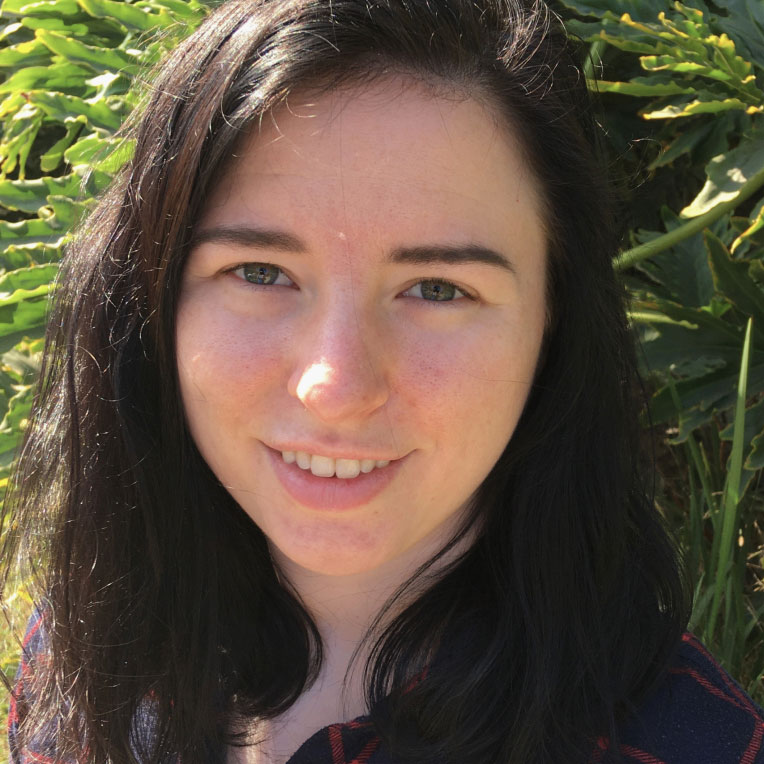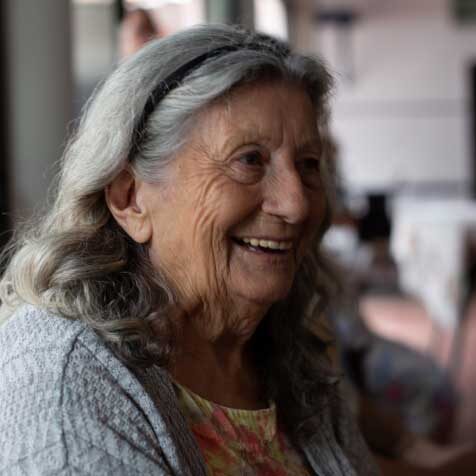Biography
Calina Glynn grew up in a small town in Connecticut as the oldest of three children. Dr. Glynn’s father is an engineer, and her mother is a librarian. The two passed their love of learning and knowledge to Dr. Glynn and her siblings. Dr. Glynn went on to become a researcher, while her younger sister pursued a career in physics and her younger brother entered the field of engineering.Growing up, Dr. Glynn was very active in sports and extracurriculars, participating in track, pole vaulting, soccer, and jazz band. She credits experienced, caring teachers with fostering her love of math and science. During high school, she especially gravitated to biology and chemistry, but as she considered what truly engaged her, neither seemed quite right — biology felt a little “vague” and chemistry seemed too “narrow.”
So when she attended Boston University as an undergraduate, she sought to bridge the tangible and the narrow with a subject that better fit her interests — and landed on biochemistry. As an undergraduate, she broke into research early because, ironically, she was struggling in a specific lab class. She went to her professor's office hours every week to ensure she understood the material. During those regular meetings, she asked him about careers in science, including what a future in research would look like. During one of those discussions, her professor mentioned that someone in the chemistry department was looking for students to join her lab — and she happened to be doing work in biochemistry. After joining that lab, Dr. Glynn had many discussions with other undergraduate and graduate students, and that’s when she began to seriously consider pursuing a graduate degree.
At the same time, her undergraduate research project wasn’t going as smoothly as she had hoped. She realized she might be able to better understand what wasn’t working if she knew

what a specific protein looked like. Her desire to see how a protein might interact with other elements in the environment ultimately inspired Dr. Glynn’s next area of research: structural biology.
For graduate school, Dr. Glynn attended UCLA to study structural biology, a discipline that investigates the structure of living material. One of her professor’s first graduate students, Dr. Glynn started her work by researching aggregates of individual proteins that become misfolded in prion diseases. Prion diseases are transmissible brain diseases that occur when a normal prion protein malfunctions, assembling itself into aggregates called “prions” that cause disease. Mad cow is one example of prion disease.
After earning her Ph.D., Dr. Glynn continued her research career at Harvard. Today, Dr. Glynn is a postdoctoral research fellow at Harvard Medical School and Massachusetts General Hospital. She hopes her research will expand our fundamental understanding of how protein structure relates to function and disease.
“In research, everything is complicated. It takes a very long time to figure things out. You have to make sure everything is safe, that it does what you intend it to do, and that it doesn’t do too many things you don’t want it to do.”
– Dr. Calina Glynn

Biography
Calina Glynn grew up in a small town in Connecticut as the oldest of three children. Dr. Glynn’s father is an engineer, and her mother is a former librarian. The two passed their love of learning and knowledge to Dr. Glynn and her siblings. Dr. Glynn went on to become a researcher, while her younger sister pursued a career in physics and her younger brother entered the field of engineering.
Growing up, Dr. Glynn was very active in sports and extracurriculars, participating in track, pole vaulting, soccer, and jazz band. She credits experienced, caring teachers with fostering her love of math and science. During high school, she especially gravitated to biology and chemistry, but as she considered what truly engaged her, neither seemed quite right — biology felt a little “vague” and chemistry seemed too “narrow.”
So when she attended Boston University as an undergraduate, she sought to bridge both disciplines with a subject that better fit her interests — and landed on biochemistry. As an undergraduate, she broke into research early because, ironically, she was struggling in a chemistry class. She went to her professor's office hours every week to ensure she understood the material. During those regular meetings, she asked him about careers in science, including what a future in research would look like. During one of those discussions, her professor mentioned that someone in the chemistry department was looking for students to join her lab — and she happened to be doing work in biochemistry. After joining Dr. Perlstein’s lab, Dr. Glynn had many discussions with other undergraduate and graduate students, and that’s when she began to seriously consider pursuing a graduate degree.
At the same time, her undergraduate research project wasn’t going as smoothly as she had hoped. She realized she might be able to better understand what wasn’t working if she knew what the protein she was studying looked like. Her desire to see how proteins might interact with other elements in the environment ultimately inspired Dr. Glynn’s next area of research: structural biology.
For graduate school, Dr. Glynn attended UCLA to study structural biology, a discipline that investigates the structures underlying the functional building blocks of life. As her professor’s (Prof. Jose Rodriguez) first graduate student, Dr. Glynn started her work by researching aggregates of individual proteins that become misfolded in prion diseases. Prion diseases are transmissible brain diseases that occur when a normal prion protein malfunctions, assembling itself into aggregates called “prions” that cause disease, where Mad Cow is an example prion disease.
After earning her Ph.D., Dr. Glynn continued her research career at Harvard. Today, Dr. Glynn is a postdoctoral research fellow at Harvard Medical School and Massachusetts General Hospital with Prof. Brad Hyman. She hopes her research will expand our fundamental understanding of how protein structure relates to function and disease.
“In research, everything is complicated. It takes a very long time to figure things out. You have to make sure everything is safe, that it does what you intend it to do, and that it doesn’t do too many things you don’t want it to do.”
– Dr. Calina Glynn

Research Focus
Challenges
Neurodegenerative diseases are incredibly prevalent and devastating. Millions of people in America live with Alzheimer’s or Parkinson’s disease, two of the most common neurodegenerative diseases. Despite many promising avenues of research, there is still much we do not understand about these types of diseases.
Focus and Priorities
In many neurodegenerative diseases, like Alzheimer’s disease, tau proteins misfold into filamentous structures, similar to the structures found in the prion diseases Calina studied at Boston University. Tau takes on a particular misfolded structure in many diseases. For example, if you look at filaments from Alzheimer’s patients and CTE (chronic traumatic encephalopathy), they’ll look the same. Despite this connection, there is much that scientists don’t understand about these proteins. They don't know how the filaments cause neurodegenerative disease. They don’t know how the filaments are interacting with other components in the affected cells. It’s also not clear how the filaments are moving from one cell to another. This lack of understanding means
Focus and Priorities
In many neurodegenerative diseases, like Alzheimer’s disease, tau proteins misfold into filamentous structures, similar to the structures found in the prion diseases Calina studied at UCLA. Tau takes on a particular misfolded structure in many diseases. For example, if you look at filaments from Alzheimer’s patients and CTE (chronic traumatic encephalopathy), they’ll look similar, but upon more detailed observation take on distinct architectures. Despite this connection, there is much that scientists don’t understand about these proteins. They don't know if or how the filaments cause neurodegenerative disease. They don’t know how the filaments are interacting with other components in the affected cells. It’s also not clear how the filaments are moving from one cell to another. This lack of understanding means there is a significant gap in knowledge about this fundamental aspect of neurological disease.
Dr. Glynn is investigating how exactly those filaments are disrupting cells. Is there a process for their removal that is being interrupted or broken? Are the filaments disrupting the membranes of the cells? Are they limiting the mobility of the cell or its internal components?
Using a process called cryo-electron tomography (cryo-ET), Dr. Glynn can create images of pieces of individual cells using an electron microscope, preserving the environmental factors instead of studying the filaments in isolation.
there is a significant gap in knowledge about this fundamental aspect of neurological disease.
Dr. Glynn is investigating how exactly those filaments are disrupting cells. Is there a process for removal that is being interrupted or broken? Are the filaments disrupting the membranes of the cells? Are they limiting the mobility of the cell?
Using a process called cryo-electron tomography (cryo-ET), Dr. Glynn can create images of pieces of individual cells using an electron microscope, preserving the environmental factors instead of studying the filaments in isolation.
Benefits
Through this research, Dr. Glynn seeks to provide foundational knowledge that other scientists can build on as they research neurodegenerative diseases. Ultimately, she hopes her work will bring us one step closer to effective treatments for these diseases.
Karen Toffler Charitable Trust Investment
The equipment required to study proteins in the cell’s environment is rare, so it is extremely expensive to use. Funding from the Karen Toffler Charitable Trust ensures Dr. Calina Glynn can spend the time she needs using this equipment to investigate how tau filaments are disrupting cells. Dr. Glynn hopes that, as she continues to generate new findings, her research will give scientists a better understanding of how filaments change cells.
Karen Toffler Charitable Trust Investment
The equipment required to study proteins in the cell’s environment is rare, so it is extremely expensive to use. Funding from the Karen Toffler Charitable Trust ensures Dr. Claina Glynn can spend the time she needs using this equipment to investigate how tau filaments are disrupting cells. Dr. Glynn hopes that, as she continues to generate new findings, her research will give scientists a better understanding of how filaments change cells.
“Structural biology helps scientists understand why a particular drug or treatment works. It helps us uncover other areas that we might pursue, additional treatments that could be effective. But this process only works if scientists are looking at why something works, not just at what works and what doesn’t.”
– Dr. Calina Glynn